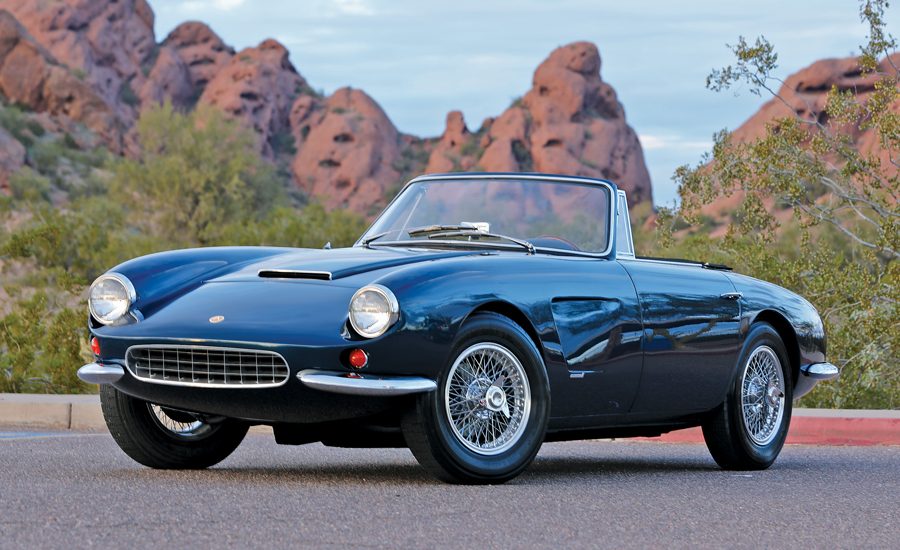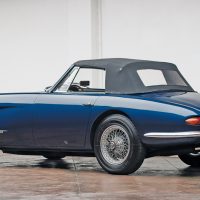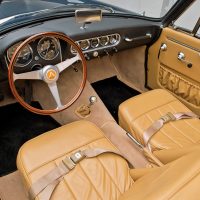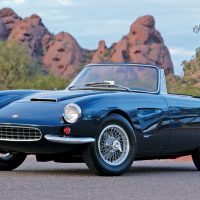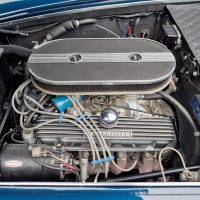- The first Apollo Spider produced
- One of just five remaining and the only aluminum-block example built
- Impeccable bodylines, striking European styling and all-alloy V8 power
- Designed by Franco Scaglione
- Restored by IMC engineer and co-founder Milt Brown
SCM Analysis
Detailing
| Vehicle: | 1964 Apollo 3500 GT Spider |
| Years Produced: | 1963–64 |
| Number Produced: | 11 (Spider) |
| Original List Price: | $7,000 |
| SCM Valuation: | $327,500 |
| Tune Up Cost: | $350 |
| Chassis Number Location: | Data tag on firewall |
| Engine Number Location: | Below dipstick tube on driver’s side of block |
| Alternatives: | 1969 LMX Sirex 2300, 1969 Intermeccanica Italia, 1965 Iso Grifo |
| Investment Grade: | B |
This car, Lot 153, sold for $506,000, including buyer’s premium, at Worldwide Auctioneers’ Corpus Christi, TX, sale on October 5, 2019.
The 1960s and early 1970s were a fertile time for those with the vision, connections and financial wherewithal to create new sports and GT car brands. These almost always followed a set plan, combining existing, readily available production engines with sexy Italian bodywork.
The combination seemed unbeatable — if these modern-day alchemists could find the sure-fire formula to capture the romance, style and performance of a Ferrari or Maserati for their clientele without the worries of dealing with finicky, expensive and complicated mechanicals, what could be a more secure path to success?
That none of them quite worked out as intended, from the fully factory-backed DeTomaso Pantera through the Ghia 450 SS and Intermeccanica Italia to the LMX Sirex 2300, may have been due less to the planning of their makers and more to the unfortunate confluence of increasing regulations and Italian labor unrest.
Ultimately, the oil crisis of 1973 crippled the market for thirsty play cars. Most of these companies also suffered from insufficient capitalization — the chief reason for the failure of the Apollo.
Coulda, woulda, shoulda
Milt Brown’s project should have had a better outcome than it did. His aptly named International Motors of Oakland, CA, built the cars with Buick V8 engines in the bodies created in Italy by Frank Reisner’s Carrozzeria Intermeccanica in Turin.
The cars were then sold in the United States. Ron Plescia’s original design — more than a bit reminiscent of contemporary Italian GTs — was expertly revised and refined by Franco Scaglione, who was at the top of his game. The result was thoroughly suited to the assignment of expressing the combination of U.S. muscle and Italian couture.
Interest continues to build in modern-day hybrids. As the experiential continues to drive collector interest, the appeal of a car that looks great and can be driven with a sense of abandon thanks to inexpensive-to-maintain mechanicals grows exponentially.
At the auction block
Helping boost this sale was the presence of the first Apollo 3500 GT coupe as well. Also on hand was one of the last cars in the series produced, a 1966 Vetta Ventura, which was built in Texas by Vanguard Industries with the 4.9-liter Buick V8 engine that was the development of the 3.5-liter Apollo. However, by the time that particular car was built, Milt Brown was out of the picture. As was the case with so many of these would-be dream cars, two other companies built the last examples.
The rebadged Vetta Ventura, presented as an Apollo 5000 GT, sold for $165,000.
The highest recorded auction price of an Apollo 3500 GT had been the $134,400 achieved at RM Sotheby’s in Phoenix, AZ, in January 2019.
The $242,000 for which Worldwide sold the first coupe and the $165,000 for the rebranded coupe seem to be notable — but not excessive — premiums.
That the car RM Sotheby’s sold in Phoenix was offered for sale again at Mecum Phoenix in March — and was a no-sale at a called $130,000 — seems odd, but the consignor probably had reasons to sell.
A changed car market
This sale (once again) illustrates the realities of today’s market.
For those who say it’s a market in decline, or even in correction, I offer that it’s a market moving further towards a rational maturity.
You can’t find another “first” production example, and when that example, in the case of our subject car, is also very well presented and well marketed, what seems an extraordinary result is to me simply the correct market on the day that the object was presented for sale.
That Milt Brown himself was involved in the restoration was certainly another positive factor — as was the fact that all the cars were from the collection of Apollo’s original sales manager, George Finley.
Worldwide did a terrific job of putting the car forward. When I saw it on display in January at their Scottsdale sale, I was immediately taken by it. It is, in my mind, the most attractive of all the Apollo cars built and was breathtaking to behold. The color combination was spectacular, showing off the lines of the car to their best advantage.
The Apollo coupe is an attractive car, but the Spider is amazingly beautiful. The auction company steadily stoked interest through the next nine months, and anyone who thought they might want it was on notice that they would have a chance in October.
The estimate was not published, but when I inquired back in January, I was given a number that was quite a bit lower than the eventual sold price.
I was not surprised at the first figure, which would have been a record price for an Apollo — by a large margin.
And I’m equally unsurprised by the final price at Worldwide’s October sale.
It was a perfect example of a special car bringing a well-above-expected price in what is largely considered a market in correction, a buyer’s paradise.
Occasionally and appropriately, a seller can prevail in this kind of market, and a buyer can obtain something unrepeatable and therefore correctly bought. ♦
(Introductory description courtesy of Worldwide Auctioneers.)
